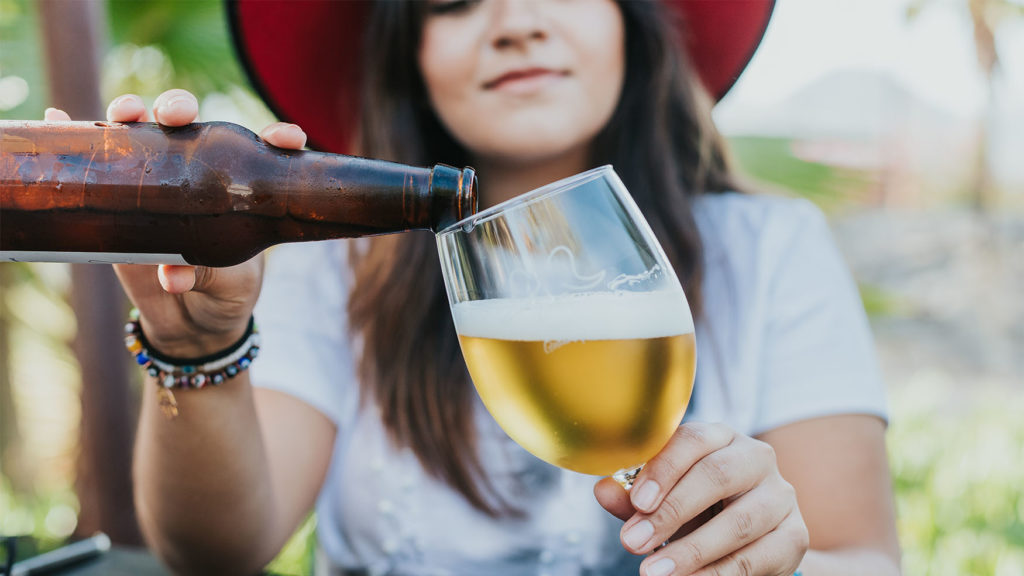As latests figures show, the no- and low-alcoholic market is rising. Meet the people driving this sober renaissance.

As pubs opened Monday, many enjoyed a fresh pint with friends. Tuesdays, however, nauseating headaches and unforgiving hangovers had probably followed them throughout the day.
We have all been here, swearing not to touch alcohol again. But, how’s saying goodbye to your favourite drink?
“About three years ago, I was having a month off booze and I tried lots of different beers. I then came across Big Drop and I had to look at the can to make sure that what I was drinking was actually alcohol free,” said Nick Heath, who then decided to invest into the brewery.
Big Drop opened its doors in 2016, being the first solely alcohol free (AF) brewery in the UK. In just about five years, the no and low-alcohol (NoLo) sector has grown with no signs to stop. In January 2020, BrewDog even opened the world’s first AF pub in London.
“We like to think that we have helped with that revolution,” said Nick , “AF beer caught up and it’s now competing with its full-strength cousins.”

This is not a one-off story. When Joelle Drummond and Sarah McNena decided to have a break for alcohol, they both got disappointed by the AF options available. So, they took things in their own hands and started a company in 2019, Drop Bear Beer.
“We realised that the market growth was really good and exciting. There was a big gap in the product range and for a brand like us it was an opportunity,” said Drop Bear Beer co-founder Joelle, “there was more room for women too. So, we decided to take it.”
In October, they are opening an AF brewery near Cardiff. It will be the first of its kind in Wales.
Latest figures reveal that the UK beer industry is at its saturation point with craft beer sales slowly going down, now coming to 1.2 million hectoliters. The NoLo market however has more than doubled since 2016. New players are entering the fray, bringing fresh innovations to the market.
According to the 2021 report carried out by drink market specialist IWSR, the worldwide NoLo sector is expected to grow by 31% by 2024. They looked at 10 markets, among which figure the UK, US, Germany and Spain. These make up 75% of the global consumption of no and low-alcohol beverages.

“What we’re seeing is a moderation trend that’s sweeping across key global markets, and that’s bringing with it increased demand for reduced-alcohol, or alcohol-free drinks,” said IWSR CEO Mark Meek.
Indeed, the AF phenomenon is not limited to beer. There are non-alcoholic spirits and even wines. Although, beers and ciders represent the 92% of the total market.
Explaining where high demand for NoLo is coming from, Neil Walker, heads of communications at SIBA (The Society of Independent Brewers), said: “Across the board people are drinking less but better, and this shift towards quality has helped the sector massively.
“Expanding the range of quality independent beers to include these super-low alcohol options can only be a good thing and allows people who are looking to cut down their alcohol intake to enjoy great tasting drinks.”
The wellness-focused lifestyle has been a big component to drive this growth. Initiatives such as Dry January and Sober October have introduced these new options to consumers that otherwise may not have tasted them.
However, this is only part of the reason. According to Joelle from Drop Bear Beer, it is the flavour closer to real beer helping the market. “The majority of our customers actually drink alcohol, they just drink alcohol-free variant sometimes. Consumers now consider alcohol-free beer as a real option,” she said.

In the picture: Drop Bear Beer founders Sarah McNena and Joelle Drummond. Copyright: Drop Bear Beer.
Production wise, brewers are getting creative, playing with ingredients and temperatures. “What we’re trying to do is demonstrating that whatever craft beer can do, AF craft beer can do it too,” said Nick from Big Drop.
Many see the reduced attraction of millennials towards alcoholic products as the driving force behind the NoLo drinks’ boom. Brewers do not share the same view.
As both Joelle and Nick pointed out, people who never drink beer before are less likely to go for a AF counterpart. Statistics show that 58% of consumers drink NoLo and full strength products on the same occasion.
According to Joelle from Drop Bear Beer, this simplistic view could even stigmatise the sector itself: “If people talk about it as a product for teetotallers, then customers may not want it because then they might feel that it is not for them.
“It’s just about creating something that is accessible to as many people as possible. That’s why we are vegan, that’s why we’re low calorie, that’s why we’re natural and that’s why we’re gluten free. The challenge is getting people to confront the product within open minds.”
Why do young people decide to stay sober?
Whether they are just sober, curious or teetotal, more and more young people are deciding to quit alcohol. Why this? How do they manage to do it?
Here, some experiences of those who have fully embraced a sober lifestyle.
